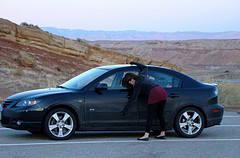If you’re leasing a car, the day will ultimately come when those expensive monthly payments finally come to an end. And then, absolute reality hits you. You’ve just spent hundreds of dollars monthly for several years on end, and it’s time to return the car back to the dealer. Lease buyouts can offer a substitute to walking away from the dealership with nothing to show for your hard earned cash.
If you decide to keep your car at the end of the lease, you should do a little research to make sure that you’re getting a fair deal. First, you need to know the full amount involved in buying out your lease. Read the fine print in your agreement, and find the “purchase option price”. This amount is set by the leasing company and is normally composed of the residual value of the car at the end of the lease, plus a purchase-option fee ranging anywhere from $300 to $500.
Residual Value
When you initially signed your lease, your monthly payments were computed as the difference between the vehicle’s sticker price and its estimated value at the end of the lease, plus a supplementary monthly financing fee. In leasing jargon, this estimated value of your car at the end of the lease is called the “residual value”. This approximated price shows the expected depreciation (lost value) of the vehicle over the scheduled lease period. For instance, a car with an initial sticker price of $40,000 that carries a 50% residual percentage will have an estimated residual value of $20,000 at contract end.
Market Value

flickr.com/amber-rae
Once you agree on the actual cost of buying out your lease, you need to find out what the actual or “market value” of your vehicle is. You’ll need to do some research to conclude just how much your car could sell for a current market retail prices. Check similar vehicles that are currently for sale, and compare the mileage, price, and overall condition. Look to Internet resources like Cars.com , Edmunds.com , and check the Kelly Blue Book for detailed pricing information. When you find several similar vehicles and use a variety of pricing information resources, you should be able to make a fair approximation of your vehicle’s market value.
When you have determined the market and residual values, it’s time to get down to the nitty-gritty. The final method is to compare the amounts to determine whether a lease buyout is in your ideal interest. If possible, the residual value will be lower than the actual retail value. However, it is more likely that the after-lease retail value will be a little on the high side.
Don’t lose hope. Your leasing company recognizes that the residual value on your vehicle will likely be greater than the market value, and the company will be on the lookout for an offer. You can use some smooth strategies to negotiate a lower buyout price for your vehicle. Offer a price that is below your actual target, and bargain until you come within range of the price you want to pay.
If you’ve spent years making costly monthly lease payments on your car and you’re just not willing to walk away empty-handed, look into a lease buyout.